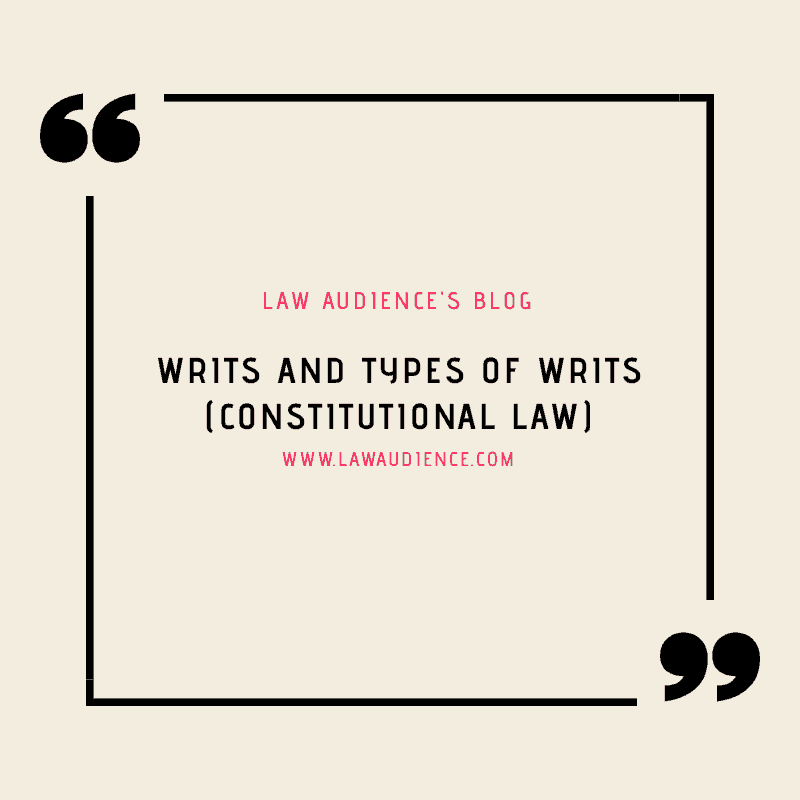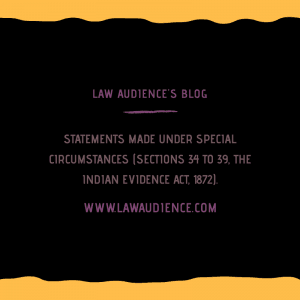AUTHORED BY: MR. PRANAV TOMAR, B.A.LL.B, 1ST YEAR STUDENT AT RAJIV GANDHI NATIONAL UNIVERSITY OF LAW & RESEARCH WRITER AT LAW AUDIENCE
I. INTRODUCTION:
When India got independence, there was a common consensus in forming a Constitution for the independent nation. The objective behind this was to create a super-structure which governs the nation by installing the reign in the hands of the people and whenever there is a threat to human rights, the Constitution will rule to safeguard the innocent.
The constitution has enshrined six basic human rights under the heading Fundamental Rights in its Part III. The framers of the constitution knew that merely adding a list of rights in the Constitution won’t be sufficient to uphold their sanctity. So, in order to manage their functioning, stalwarts of the drafting committee inserted Article 32 under Fundamental Rights which allows the judiciary to interfere in the matter which infringes the Fundamental Rights of the individual. This Article came to be known as Right to Constitutional Remedies. According to Dr. B. R. Ambedkar (chairman of the drafting committee), Article 32 is the ‘Heart and Soul of the constitution’. Why not it be? This article is responsible to give justice to an individual if his rights are violated which is, in turn, the foundational principle of the Constitution. Article 32 lays down five writs that allow the court to enforce Fundamental Rights.
A Writ can be defined as a written command issued by any legal authority order to act or abstain from acting in a certain way. These five writs are Habeas Corpus, Mandamus, Quo-Warranto, Prohibition, and Certiorari.
II. TYPES OF WRITS:
a) HABEAS CORPUS:
This Latin phrase means “to produce the body”. This writ is used for securing liberty. By the help of this writ, the court can direct a person/organization (who has detained any other person) to bring the body before the court so that it can check the validity or jurisdiction of the arrest. The basic objective of the writ is to ensure smooth judicial review in the matters of unlawful detention of liberty or freedom. This writ supports Article 22 of the Fundamental Rights where it is required by the police officer to produce the arrested person before a magistrate within 24 hours of his arrest. Failing to comply by this period will lead to the release of the said person. But the scope of writ limits itself when the person is under custody backed by a judicial order of the competent court. The writ of Habeas Corpus can be sanctioned not only against the state but also against any individual who is falsely imprisoning the person. Judiciary has been active in expanding the scope of this writ.
The court held that it is not necessary that the detainee to be the petitioner. Any interested party who has some connection with the party may also do so.[1]
In the case Gopalan v. Union of India,[2] the apex court ruled that the earliest date with reference to which the legality of detention may be examined is the date on which the application for the same is made to the court.
b) MANDAMUS:
The Latin word Mandamus means ‘we command’. The writ represents a command issued by a court to an organization/authority pointing it to perform a duty duly imposed upon it by law.[3] For instance, when a body (judicial/quasi-judicial) omits its duty to decide on a certain matter, this writ can command that body to decide the matter as early as possible. The objective of this writ is to keep a check if the public authority is working within the limits of their jurisdiction while performing statutory functions. The scope of this writ limits itself against the acts of the government which it is not duty-bound by the law. The writ can only be issued when authority fails in its legal duty to enforce an order which it was supposed to do. It can be issued to bodies performing administrative, legislative, judicial and quasi-judicial functions. It will not be necessary that the duty is imposed by the statute. It has a much bigger purview applying to the cases where the duty is imposed by the common law or customs.[4] The ambit of the writ is has been expanded with time.
c) QUO WARRANTO:
The Latin phrase Quo Warranto means ‘by what authority’. This writ is issued in directing the subordinate extending a judicial control in the matters concerning the appointment of officers under relevant statutory provisions. Its aim is to question the authority of an individual of the office he is holding. It asks the question ‘by what warrant’ the person is holding the concerned office or by what power of the provision he/she is extracting power. The writ asks the holder of the office to show to the court the authority under which he’s holding the concerned post. If the person is not entitled, he will be asked by the court to vacate his post.
In the case G. Venkateshwara Rao v. State of Andhra Pradesh[5], the court declared that if a private individual files an appeal for a writ of Quo Warranto. It will not be a requisite for that person to be personally affected or interested in the case.
d) PROHIBITION & CERTIORARI:
Both of the writs are inter-connected to each other barring a thin line differentiating them. They are designed to control the functions of the judicial and quasi-judicial bodies. The writ of Prohibition is issued directing the subordinate judicial bodies to refrain proceedings in the cases which are ultra vires of their jurisdiction. The writ of Prohibition can only be issued when the case is pending before the authority. The writ holds that whenever a subordinate authority is shown that it has acted in excess of their jurisdiction, the court will issue a writ of prohibition regardless of whether there exists an alternative remedy or not.
The writ of Certiorari is issued to the subordinate courts having judicial or quasi-judicial powers directing them to transfer the records to the higher authority in order to make certain that the court making decision has the appropriate jurisdiction or working on the principle of natural justice. Hence, the writ of Certiorari is corrective by nature.
III. CONCLUSION:
The power to grant writs is available both to the Supreme Court[6] as well as the High Courts[7]. The idea behind enshrining writ under the constitution was to ensure speedy remedy to the citizens. But this system also has some drawbacks. For instance, the writs can only be issued to public authorities. The writ would be proofed ineffective when it comes to private bodies, contracts etc.[8] Nevertheless, writ system till now has successfully functioned as a measure to uphold the sanctity of both Democracy and Constitution. Even with little lags, it should not be underestimated.
[1] Sheela Bharse v. State of Maharashtra A.I.R. 1983 S.C. 378 (India).
[2] Gopalan v. Union of India [1950] S.C.R. 88 (India).
[3] State of West Bengal v. Nuruddin (1998) 8 S.C.C. 143 (India).
[4] Shri Anadi Mukta Sadguru Shree Muktajee Vandasjiswami Suvarna Jayanti Mahotsav Smarak Trust and Ors. v. V. R. R Udani and Ors. A.I.R. 1989 S.C. 1607 (India).
[5] G. Venkateshwara Rao v. Government of Andhra Pradesh A.I.R. 1966, S.C. 828 (India).
[6] Article 32(2) The Supreme Court shall have the power to issue directions or orders or writs, including writs in the nature of habeas corpus, mandamus, prohibition, quo warranto and certiorari, whichever may be appropriate, for the enforcement of any of the rights conferred by this Part.
[7] Article 226 every High Court shall have power, throughout the territories in relation to which it exercises jurisdiction, to issue to any person or authority, including in appropriate cases, any Government, within those territories directions, orders or writs, including 1[writs in the nature of habeas corpus, mandamus, prohibition, quo warranto and certiorari, or any of them, for the enforcement of any of the rights conferred by Part III and for any other purpose.].
[8] Anand Bihari v. Ram Sahay A.I.R. 1952 MB 3 (India).



